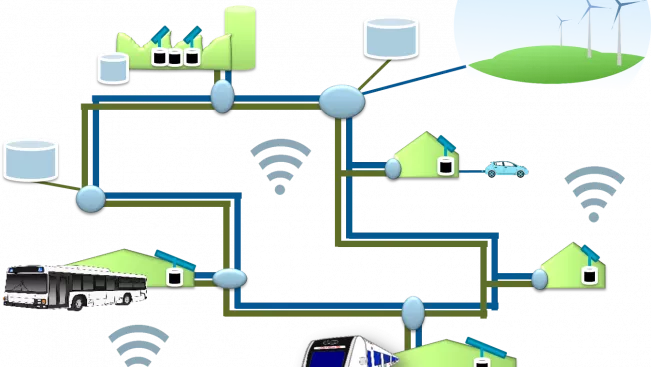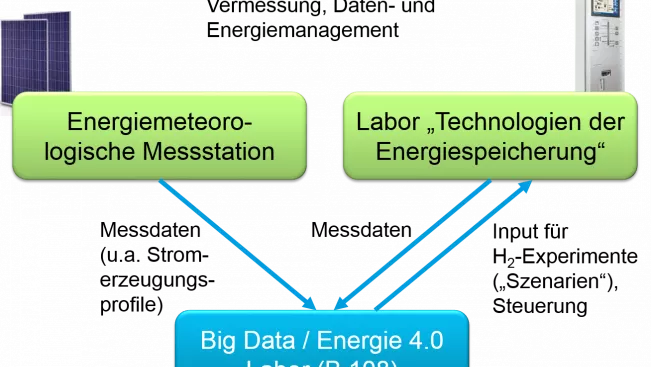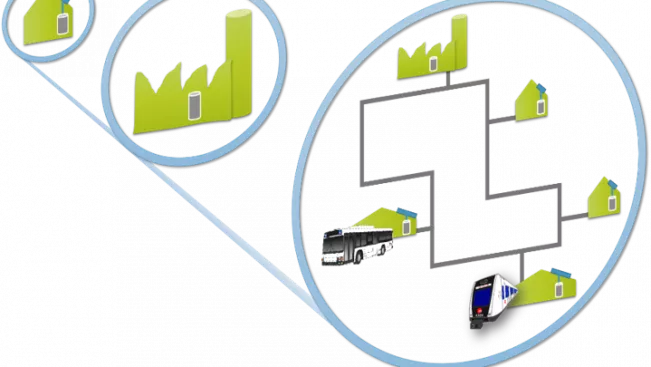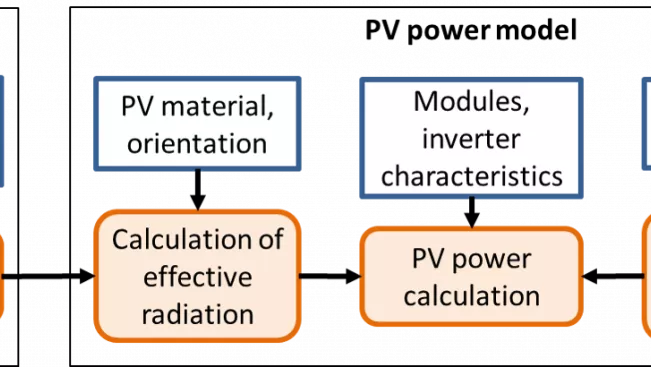Institute of Technology, Resource and Energy-efficient Engineering (TREE)
Networks working group
Current research topics
- Numerical methods for network simulation
- Grid integration of weather-dependent energy generators: simulation of the system behaviour of PV diesel hybrid systems and PV hydrogen systems
- Energy circuits Power-to-Gas-to-X
- Hydrogen or methane, that is the question here!
- Sector coupling
- Energy 4.0: Digitization and energy system transformation





Methods, competences and applications
- Since 2013, the working group has been developing its own model chain for calculating the system behaviour of energy networks under variable weather-related boundary conditions. The focus is on the effects of variable solar energy generation. In particular, an atmospheric radiation transfer model (libradtran) has been coupled with a PV power model, which in turn provides input for the modelling of electricity and hydrogen networks. There is a license for INSEL (Integrated Simulation Environment Language, from the company Doppelintegral GmbH), which allows the simulation of weathering effects on smaller electrical and thermal networks with renewable energy producers.
- In close cooperation with the Fraunhofer SCAI, the working group continues to deal with current questions concerning energy networks and contributes to the further development of the SCAI's multiphysical network simulator MYNTS. With the help of MYNTS, tasks from the areas of gas networks, heat/cold networks (water), electricity networks and sector coupling are being worked on. The know-how for analysing these networks ranges from big-data architectures, network reconstructions to approximation methods.
- The mathematical modelling of network components is performed using partial and ordinary differential equations (PDEs and ODEs) as well as linear and non-linear algebraic equations. By suitable discretisations of the spatial derivatives of the PDEs, all equations can be combined to a large system of so-called differential algebraic equations (DAEs). In the working group efficient numerical methods for the solution of such DAEs are developed and applied in the network simulation software.
Laboratories
The simulations are validated using measurement data from the energy meteorological measuring station of the Bonn-Rhein-Sieg University of Applied Sciences in Sankt Augustin. Further measurement data are recorded in the "Energy 4.0 (Big Data Laboratory)" laboratory. Another laboratory, "Technologies of Energy Storage", is currently being set up in which various concepts of a complex energy system are tested and are supported and developed with the help of simulations.
Selected Publications
2023
Gerd Steinebach:
Construction of Rosenbrock–Wanner method Rodas5P and numerical benchmarks within the Julia Differential Equations package.
PDF Download (CC BY 4.0) doi:10.1007/s10543-023-00967-x urn:nbn:de:hbz:1044-opus-67772
BibTeX | RIS
2022
Jan Kleinert, Gerd Steinebach, Dirk Reith, Philipp Spelten, Martin Kliemank, Sandro Elsweijer, Philipp Rosauer, Martin Schenk, Florian Roßbach, Victor Lüddemann, Lea Krühler, Jasmin Breuer:
Modellbildung-und-Simulation: Online Lehrbuch.
doi:10.5281/zenodo.7343027
BibTeX | RIS
2021
Gerd Steinebach, David Michael Dreistadt:
Water and Hydrogen Flow in Networks: Modelling and Numerical Solution by ROW Methods.
doi:10.1007/978-3-030-76810-2_2
BibTeX | RIS
2020
Gerd Steinebach:
Improvement of Rosenbrock-Wanner Method RODASP: Enhanced Coefficient Set and MATLAB Implementation.
doi:10.1007/978-3-030-53905-4_6
BibTeX | RIS
Gerd Steinebach, Oliver Kolb:
Hydraulic modeling and energy view.
doi:10.4171/207-1/4 URL
BibTeX | RIS
Gerd Steinebach, David Dreistadt, Patrick Hausmann, Tim Jax:
Setup of simulation model and calibration.
doi:10.4171/207-1/7 URL
BibTeX | RIS
Tim Jax:
Network aggregation.
doi:10.4171/207-1/6 URL
BibTeX | RIS
Patrick Hausmann:
Demand forecast.
doi:10.4171/207-1/3 URL
BibTeX | RIS
2018
Tanja Clees, Igor Nikitin, Lialia Nikitina:
Making Network Solvers Globally Convergent.
doi:10.1007/978-3-319-69832-8_9
BibTeX | RIS
Tanja Clees, Igor Nikitin, Lialia Nikitina, Lukasz Segiet:
Modeling of Gas Compressors and Hierarchical Reduction for Globally Convergent Stationary Network Solvers.
URL
BibTeX | RIS
Anton Baldin, Kläre Cassirer, Tanja Clees, Bernhard Klaassen, Igor Nikitin, Lialia Nikitina, Inna Torgovitskaia:
Universal Translation Algorithm for Formulation of Transport Network Problems.
doi:10.5220/0006831903150322
BibTeX | RIS
2017
Gerd Steinebach:
From River Rhine Alarm Model to Water Supply Network Simulation by the Method of Lines.
doi:10.1007/978-3-319-23413-7_109
BibTeX | RIS
Tim Jax, Gerd Steinebach:
Generalized ROW-type methods for solving semi-explicit DAEs of index-1.
doi:10.1016/j.cam.2016.08.024
BibTeX | RIS
2012
Gerd Steinebach, Rüdiger Weiner:
Peer methods for the one-dimensional shallow-water equations with CWENO space discretization.
doi:10.1016/j.apnum.2012.06.009
BibTeX | RIS
Gerd Steinebach, Roland Rosen, Annelie Sohr:
Modeling and Numerical Simulation of Pipe Flow Problems in Water Supply Systems.
doi:10.1007/978-3-0348-0436-3_1
BibTeX | RIS